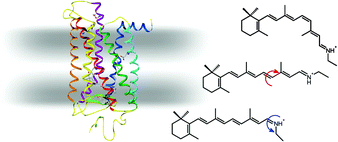Structural and functional properties of metarhodopsin III: Recent spectroscopic studies on deactivation pathways of rhodopsin
Abstract
The

* Corresponding authors
a
Institut für Medizinische Physik und Biophysik, Charité-Universitätsmedizin Berlin, Campus Charité Mitte, Schumannstrasse 20-21, Berlin, Germany
E-mail:
franz.bartl@charite.de
Fax: +49 30 450 524952
Tel: +49 30 450 524111
b Zentrum für Biophysik und Bioinformatik, Humboldt Universtität zu Berlin, Invalidenstr. 42, Berlin, Germany
c
Arbeitsgruppe Biophysik, Institut für Molekulare Medizin und Zellforschung, Albert-Ludwigs-Universität Freiburg, Hermann-Herder-Str. 9, Freiburg, Germany
E-mail:
reiner.vogel@biophysik.uni-freiburg.de
Fax: +49 761 203 5390
Tel: +49 761 203 5391
The

 Please wait while we load your content...
Something went wrong. Try again?
Please wait while we load your content...
Something went wrong. Try again?
F. J. Bartl and R. Vogel, Phys. Chem. Chem. Phys., 2007, 9, 1648 DOI: 10.1039/B616365C
To request permission to reproduce material from this article, please go to the Copyright Clearance Center request page.
If you are an author contributing to an RSC publication, you do not need to request permission provided correct acknowledgement is given.
If you are the author of this article, you do not need to request permission to reproduce figures and diagrams provided correct acknowledgement is given. If you want to reproduce the whole article in a third-party publication (excluding your thesis/dissertation for which permission is not required) please go to the Copyright Clearance Center request page.
Read more about how to correctly acknowledge RSC content.
 Fetching data from CrossRef.
Fetching data from CrossRef.
This may take some time to load.
Loading related content
